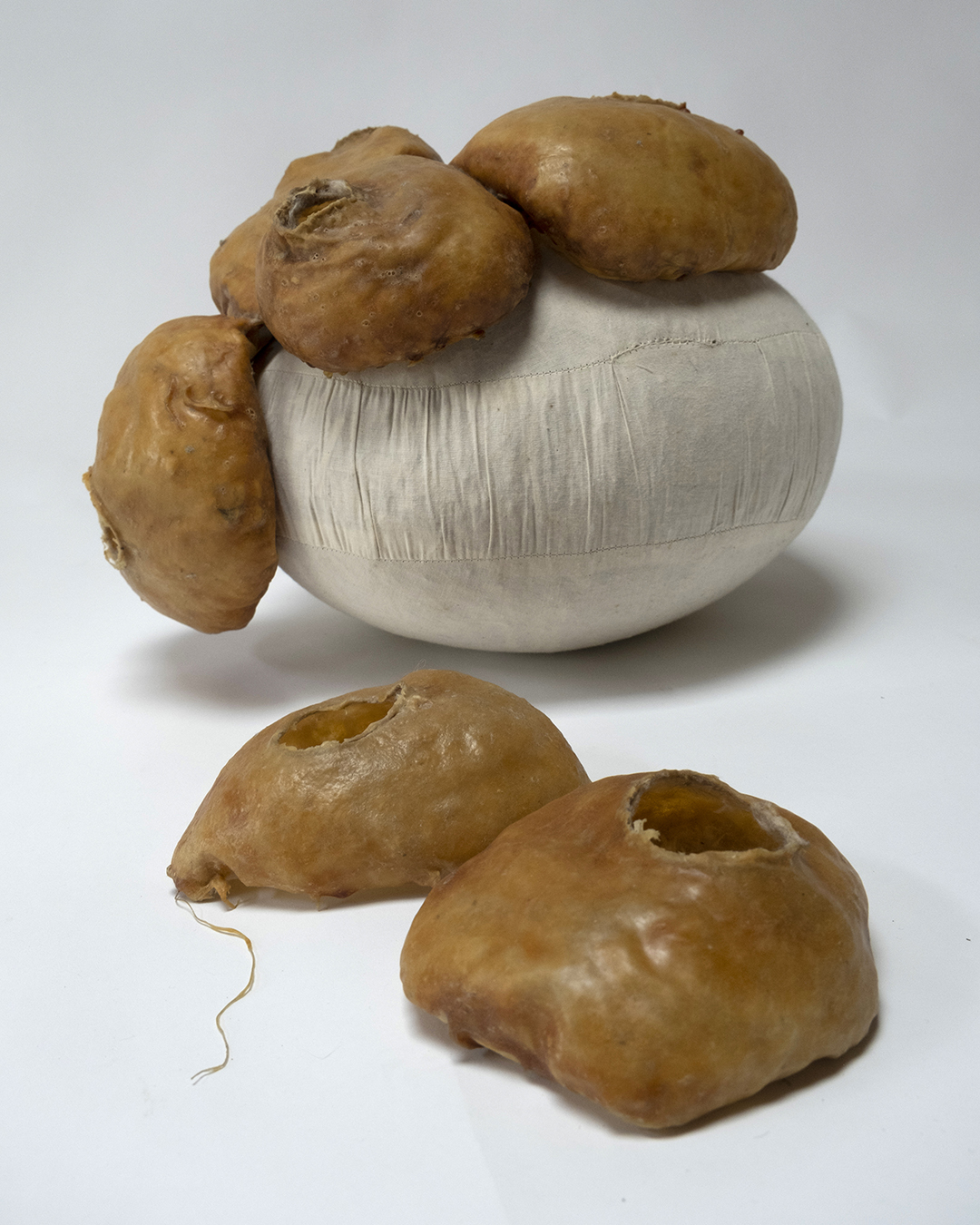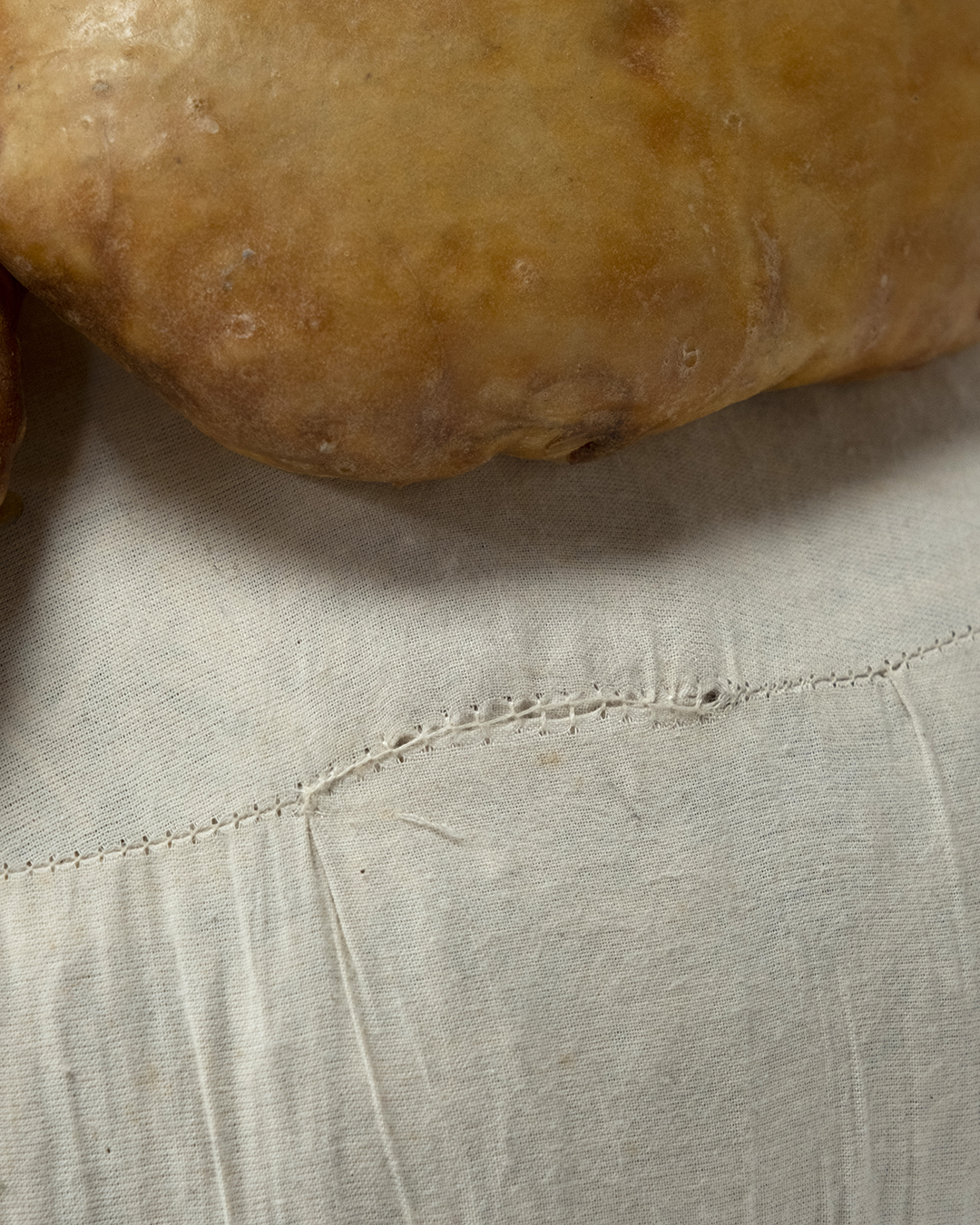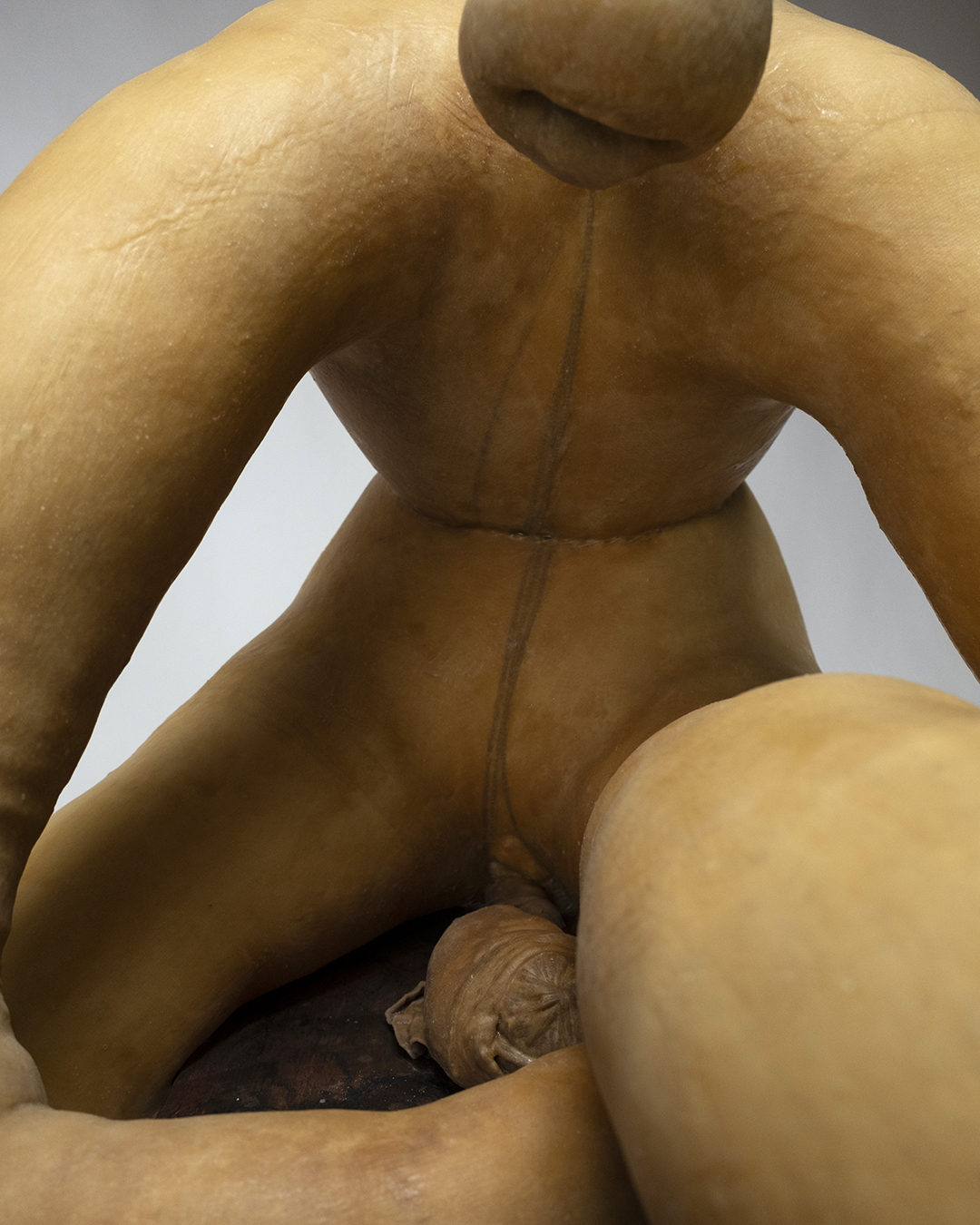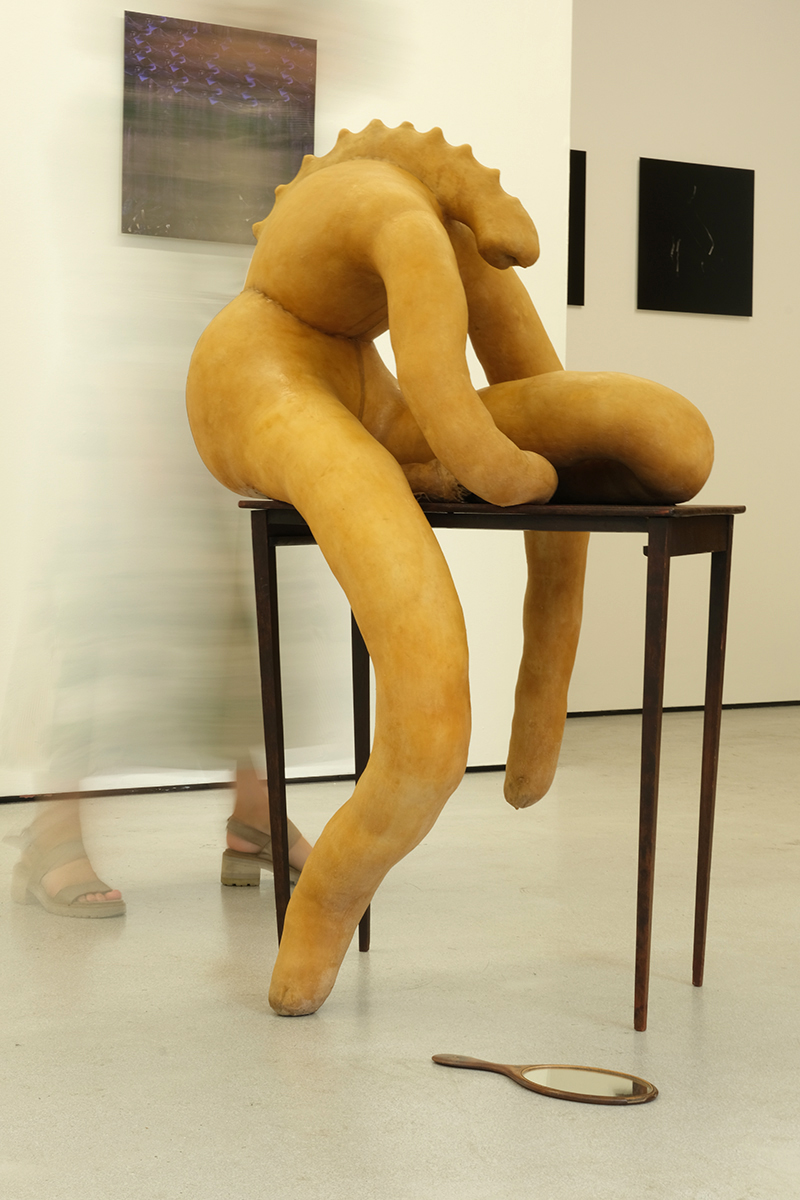Other Fruyte
Catalogue for the show here
Other Fruyte 2023
An installation for ‘Light Being’ show at Lychee One Gallery, London
![]()
![]()
The Faellan Aeppel 2023,
mixed media, silk gloves, copper wire 20 X 20 X 23 cms and gloves 40 X 8 cms
![]()
![]()
A’ Spawnen 2023
mixed media, lacemakers cushion 38 X 38 X 27cms
![]()
![]()
![]()
The Malady of Sabine 2023
mixed media, table, wooden mirror 78 X 75 X 122cms
Other Fruyte
Sitting hunched upon a table, an un-human worm-like figure cradles what could be seen as a phallus or foetus, spilling out onto the table between its legs. Then an oversized apple, with flesh-like, post-operational stitches, lays on the floor, and next to it, a pair of lace gloves, as though an unusual metamorphosis has taken place. A lace-makers cushion rests on the ground, with a spawn-like arrangement spilling down onto the floor, one could mistake this spillage as embalmed breasts or oversized watery egg cases, left while the occupants have moved on. Is this an alternative Eden?
The viewer is left alone to ponder the whereabouts and nature of these fledgling beings.
Other images jut out and circulate in this free play of sense. Lurking here are Andrei Tarkovsky's reflections of the human attached to all of its slippages of recollections of memory and dreams, and then Bela Tarr’s pessimistic visions rooted within the reality of societal hardship. Such appropriations could be said to induce a speculative vision of interior or subterranean landscapes where the protagonists are neither human nor un-human, but exist within an atmosphere that Marguerite Duras referred to as a 'hole world'.
In such places, incommensurability is the measure of everything.
Other images start to emerge. The artwork is always its double, containing an invisible archive of imaginary references - like flesh and mind folded.
Through her recording of a banal incident with a cockroach, Clarice Lispector brings into question our desire to tie down and understand reality. She goes on to form a posture that to truly ‘be’ in the world one must embrace a lack of understanding. Could this in turn implicate an approach of ‘blindness’ to established societal schemas? The systems within her worlds are always shifting and transforming as they do so.
The flesh of humans becomes the flesh of fruits. A form of celestial pregnancy?
Julia Kristeva seems to draw together this unstable landscape when she writes: “…we are seized at that fragile spot of our subjectivity where our collapsed defences reveal, beneath appearances of a fortified castle, a flayed skin (…). A universe of borders, seesaws, fragile and mingled identities, wanderings of the subject and its objects, fears and struggles, abjections and lyricisms. At the turning point between social and asocial, familial and delinquent, feminine and masculine, fondness and murder.”
Thoughts drift to other forces. Butoh dance rose from the ashes of Hiroshima and Nagasaki, disturbing representation in the process. In contrast to Western dance ideologies of the body being strong and athletic, Butoh resonates with the ‘weakness’ of the body, drawing upon grotesque imagery and environments. Time frames are subject to warping into post human worlds that disorder established schema. With this, other visions of bodies are formed and deformed.
Thus a setting is created, new lines are drawn, poetic transformations given over to light, material forms find place within all of this, making possible a joining of abjection and splendour defying measurability.
Other Fruyte 2023
An installation for ‘Light Being’ show at Lychee One Gallery, London


mixed media, silk gloves, copper wire 20 X 20 X 23 cms and gloves 40 X 8 cms


mixed media, lacemakers cushion 38 X 38 X 27cms



mixed media, table, wooden mirror 78 X 75 X 122cms
Other Fruyte
Sitting hunched upon a table, an un-human worm-like figure cradles what could be seen as a phallus or foetus, spilling out onto the table between its legs. Then an oversized apple, with flesh-like, post-operational stitches, lays on the floor, and next to it, a pair of lace gloves, as though an unusual metamorphosis has taken place. A lace-makers cushion rests on the ground, with a spawn-like arrangement spilling down onto the floor, one could mistake this spillage as embalmed breasts or oversized watery egg cases, left while the occupants have moved on. Is this an alternative Eden?
The viewer is left alone to ponder the whereabouts and nature of these fledgling beings.
Other images jut out and circulate in this free play of sense. Lurking here are Andrei Tarkovsky's reflections of the human attached to all of its slippages of recollections of memory and dreams, and then Bela Tarr’s pessimistic visions rooted within the reality of societal hardship. Such appropriations could be said to induce a speculative vision of interior or subterranean landscapes where the protagonists are neither human nor un-human, but exist within an atmosphere that Marguerite Duras referred to as a 'hole world'.
In such places, incommensurability is the measure of everything.
Other images start to emerge. The artwork is always its double, containing an invisible archive of imaginary references - like flesh and mind folded.
Through her recording of a banal incident with a cockroach, Clarice Lispector brings into question our desire to tie down and understand reality. She goes on to form a posture that to truly ‘be’ in the world one must embrace a lack of understanding. Could this in turn implicate an approach of ‘blindness’ to established societal schemas? The systems within her worlds are always shifting and transforming as they do so.
The flesh of humans becomes the flesh of fruits. A form of celestial pregnancy?
Julia Kristeva seems to draw together this unstable landscape when she writes: “…we are seized at that fragile spot of our subjectivity where our collapsed defences reveal, beneath appearances of a fortified castle, a flayed skin (…). A universe of borders, seesaws, fragile and mingled identities, wanderings of the subject and its objects, fears and struggles, abjections and lyricisms. At the turning point between social and asocial, familial and delinquent, feminine and masculine, fondness and murder.”
Thoughts drift to other forces. Butoh dance rose from the ashes of Hiroshima and Nagasaki, disturbing representation in the process. In contrast to Western dance ideologies of the body being strong and athletic, Butoh resonates with the ‘weakness’ of the body, drawing upon grotesque imagery and environments. Time frames are subject to warping into post human worlds that disorder established schema. With this, other visions of bodies are formed and deformed.
Thus a setting is created, new lines are drawn, poetic transformations given over to light, material forms find place within all of this, making possible a joining of abjection and splendour defying measurability.